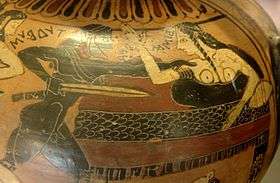Ismene

Ismene (/ɪsˈmiːniː/; Ancient Greek: Ἰσμήνη, Ismēnē) is the name of the daughter and half-sister of Oedipus, daughter and granddaughter of Jocasta, and sister of Antigone, Eteocles, and Polynices. She appears in several plays of Sophocles: at the end of Oedipus the King, in Oedipus at Colonus and in Antigone. She also appears at the end of Aeschylus' Seven Against Thebes.
When Oedipus stepped down as King of Thebes, he gave the kingdom to Eteocles and Polynices, who both agreed to alternate the throne every year. However, after the first year, Eteocles refused to step down and Polynices attacked Thebes with his supporters (the Seven Against Thebes). Both brothers died in the battle. King Creon, who ascended to the throne of Thebes, decreed that Polynices was not to be buried, but left to rot on pain of death.
However, Antigone defied the order and was caught. In the opening scene of the play when Antigone is about to perform the burial rituals on Polynices, Ismene serves as the compassionate but rational and prudent counterpart to Antigone's headstrong style of decision-making with no regard for consequence. While Antigone resolves to honor her brother at all costs, Ismene laments that while she too loves her brother, her disposition does not allow her to defy the state and become an outlaw. Once Antigone was caught, in spite of her betrothal to his son Haemon, Creon decreed that she was to be buried alive. Ismene then declared she had aided Antigone and wanted the same fate, though she did not participate in the crime. Antigone refused to let her be martyred for a cause she did not stand up for. She even seems to forget her sister exists, calling herself the 'last descendant of Oedipus.'
Thus, it is apparent that Ismene serves as a foil for Antigone; she is the “compliant citizen” to her sister’s “conscientious objector.”[1] While she is loyal and willing to die at her sister’s side, she does not make the same bold, defiant stand that Antigone does. Like Haemon, she is a reasonable, sympathetic person whose fate is tied to the far more fanatical Antigone and Creon.[1]
However, in Aeschylus' play, Seven Against Thebes, Ismene and Antigone sing a funeral dirge together for both of their brothers.
The 7th century BC poet Mimnermus accounts that Ismene was murdered by Tydeus. This is mentioned in no other extant Classical writing, but the scene is represented on a 6th-century Corinthian black-figure amphora now housed in the Louvre.[2]
References
- 1 2 Sophocles. Drama Classics: Antigone. McDonald, Marianne, trans. London: Nick Hern Books, 2004.
- ↑ Easterling, P. E.; Knox, B. M. W. (1989). Cambridge History of Classical Literature: Early Greek Poetry. vol. 1, part 1. Cambridge University Press. p. 95. ISBN 0-521-35981-3.